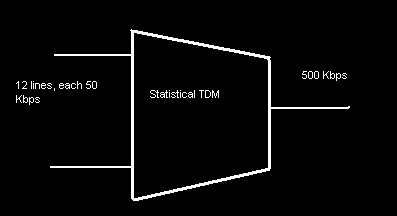
Quiz No. 4
(Take-home examination in Multiplexing)
General Instructions:
1. Answers to your examination should to be submitted in handwritten form.
2. If there are queries regarding the reading material, feel free to approach me during my consultation period.
3. First 10 persons to submit the examination will be merited with 20 extra marks.
4. Submission Date: Thursday, December 12, 2002 until 12 pm only at N205.
Late submission will merit deductions. Five points deduction for every minute late submission. Basis: RPN-9 screen time.
Note: Answers may be submitted electronically (scanned handwritten answers) through e-mail at goavendano@cisco.mapua-tech.edu.ph.
1. (5 marks) What is the purpose of a guard band in FDM?
2. (10 marks) What are the two types of TDM implementations and how do they differ from each other?
3. (5 marks) What is the function of a DSU in a switched/56 service?
4. (5 marks) What is the relationship between the number of slots in a frame and the input lines for synchronous TDM? For Asynchronous TDM?
5. (5 marks) A T-2 line offers a 6.312 Mbps service. Why is this number not 4 * 1.544 Mbps?
6. (10 marks) Four signals are multiplexed. We take one measurement n of the multiplexed signal. For FDM, what does n represent? For TDM, what does n represent?
7. (20 marks) Given the following information, find the minimum bandwidth for the path: FDM multiplexing, 6 devices, each requiring 4 KHz, 300-Hz guard band for each device.
8. (20 marks) Draw the synchronous TDM frames showing the character data given the following information: Four signal sources: Source 1 message: T E G; Source 2 message: A; Source 3 message (empty); Source 4 message: E F I L.
9. (20 marks) Four voice-grade lines, each using 4 KHz, are frequency-multiplexed together using AM and cancelling the lower modulated band. Draw the frequency-domain representation of the resulting signal if the carrier frequencies are 4, 10, 16 and 22 KHz respectively. What is the bandwidth of the resulting signal?
10. (20 marks) We have multiplexed 100 using synchronous TDM. If each computer sends data at the rate of 14.4 Kbps, what is the minimum bit rate of the line? Can a T-1 handle this situation? Explain.
11. (20 marks) Figure shows a statistical TDM multiplexer. How much is the data rate of each line reduced if all 12 lines are sending data? How many stations can send data at the same time with full capacity? Ignore extra bits for addressing.

12.(25 marks) Figure below shows a multiplexer. If the slot is only 10 bits long (three bits taken from each input plus one framing bit), what is the output bit stream? What is the output bit rate? What is the duration of each bit in the output line? How many slots are sent per second? What is the duration of each slot?
